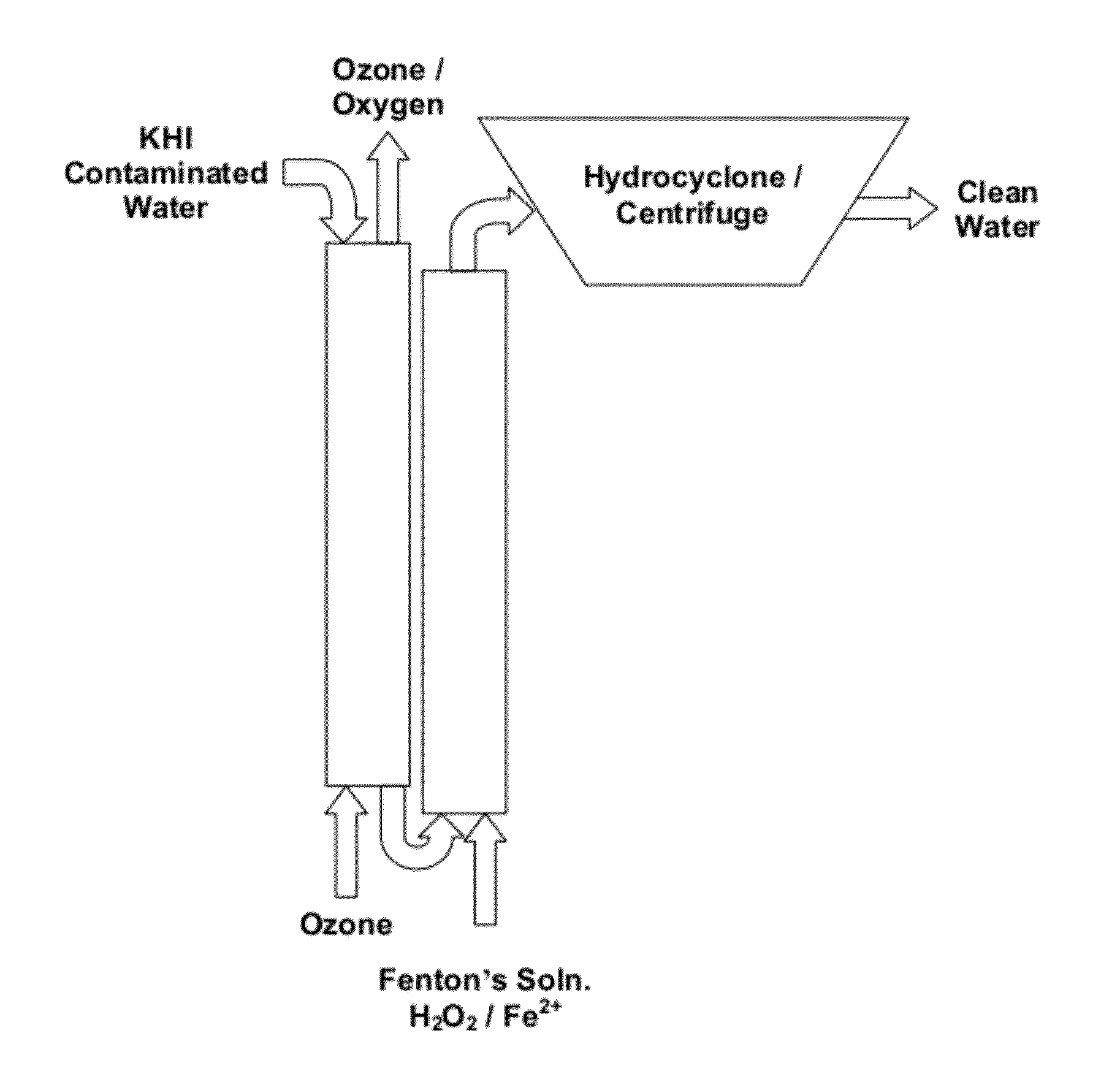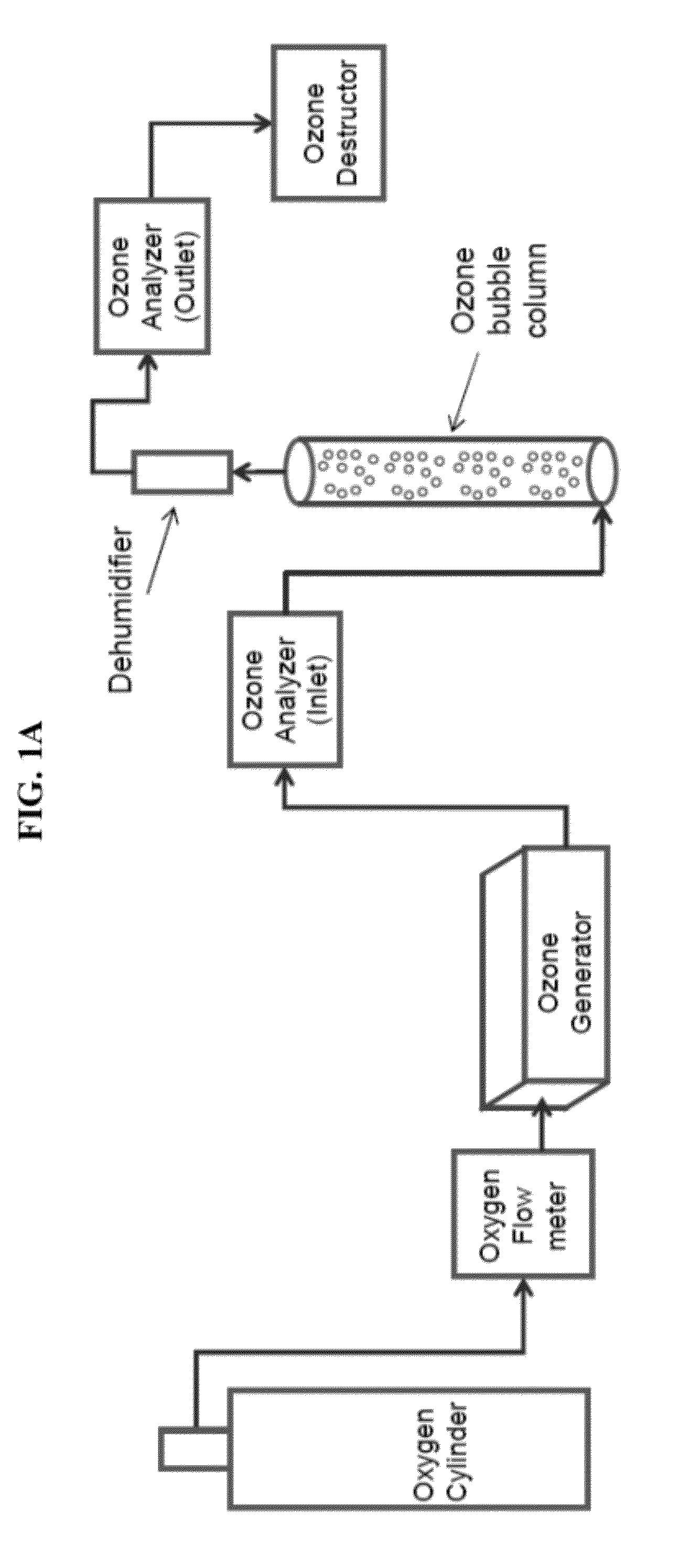Advanced oxidation of kinetic hydrate inhibitors
a technology inhibitors, which is applied in the direction of multi-stage water/sewage treatment, borehole/well accessories, separation processes, etc., can solve the problems of deterioration of pipe walls, affecting the oxidation efficiency of kinetic hydrate inhibitors, so as to reduce the amount of equipment required, reduce the cost of processing, and the effect of rapid oxidation
- Summary
- Abstract
- Description
- Claims
- Application Information
AI Technical Summary
Benefits of technology
Problems solved by technology
Method used
Image
Examples
example 1
Ozonation
[0045]Ozonation can remove up to 94% of the KHI present in wastewater (FIG. 5). In one embodiment KHI was removed from a mixed brine solution containing 1.5% KHI by bubbling ozone through the solution. A synthetic brine solution was made with 1.5% KHI, a hyper branched polymer with ethoxy functional group The solution contained 2.2715 g NaCl, 7.3128 g CaCl2.2H2O, 4.1762 g MgCl2.6H2O, 26.0295 g of 0.1M KCl, 0.1493 NaSO4, 0.1800 g NH4Cl; 0.1591 g SrCl2.6H2O, 1.6081 g NaC2H3O2, and 30.0117 g of hyper branched KHI, pH was adjusted to 8.83 in 2 L aqueous solution. This synthetic brine is similar to brine separated from sludge catcher of crude oil / LNG production at several facilities.
[0046]Ozonation was first run through the synthetic brine without KHI as previously described. 1 liter of water with oxygen flow at 0.4 lt / min was run through an ozone bubbling column (see FIG. 1) with DI water. Inlet ozone was approximately 194.9 gN / m3 to 195.1 g / Nm3 and the outlet ozone concentrati...
example 2
pH Effects
[0053]Synthetic brine was mixed with KHI to produce an initial solution with 0.25% KHI (mixed for at least one hour). The pH in two separate brine solutions was adjusted to pH 3.5 and pH 9.0.
[0054]Ozone was bubbled for one hour with the following parameters: 250 ml of synthetic brine with 0.25% KHI, mixed for greater than one hour, was treated by ozonation with an oxygen flow rate of 0.075 Nit / min, 4.5 PSI, generating 180 gN / m3 ozone at the inlet with ozone mass flow rate of 0.78 g / h ozonation. Samples (4 ml) were taken at 5, 10, 20, 30, 45 and 60 minutes. After 60 minutes, the solution was purged with oxygen to remove the remaining ozone gas.
[0055]synthetic brine with 0.25% KHI at pH 3.5 had 2524 mg / L KHI and an initial cloud point of 42° C. and was completely opaque at 53° C. OPCO Brine with 0.25% KHI at pH 9.0 had 2431 mg / L KHI and an initial cloud point of 42° C. and was completely opaque at 53° C. After bubbling in ozone for 60 minutes, the solutions had dramatic redu...
example 3
Fenton Process
[0056]The Fenton process was conducted by mixing hydrogen peroxide (H2O2) with the KHI solution and adding ammonium ferrous sulfate hexahydrate (NH4FeSO4.6H2O). Mixing the H2O2 with NH4FeSO4.6H2O releases oxygen radicals producing hydroxyl ions and hydroxyl radicals, that may then react with reactive groups in the KHI (FIG. 4). In one embodiment, a 0.25% KHI brine solution was treated using the Fenton Process to remove KHI. In a 500 ml volumetric flask, 100 ml concentrated 5 fold concentrated synthetic brine was mixed with 100 ml of 12.5 mg / ml KHI for 1 hour. Next, 157 ml of 6% H2O2 was added along with 100 ml 66.3 mg / ml NH4FeSO4.6H2O. The flask was filled to 500 ml with deionized water for a final volume of 500 ml. After stirring, the solution was allowed to settle. The solution color goes from transparent to light orange to opaque dark orange. After several hours, the iron oxides precipitated to the bottom of the flask and the solution returned to a transparent light...
PUM
| Property | Measurement | Unit |
|---|---|---|
| pH | aaaaa | aaaaa |
| ionic concentrations | aaaaa | aaaaa |
| ionic concentrations | aaaaa | aaaaa |
Abstract
Description
Claims
Application Information
 Login to View More
Login to View More - R&D
- Intellectual Property
- Life Sciences
- Materials
- Tech Scout
- Unparalleled Data Quality
- Higher Quality Content
- 60% Fewer Hallucinations
Browse by: Latest US Patents, China's latest patents, Technical Efficacy Thesaurus, Application Domain, Technology Topic, Popular Technical Reports.
© 2025 PatSnap. All rights reserved.Legal|Privacy policy|Modern Slavery Act Transparency Statement|Sitemap|About US| Contact US: help@patsnap.com



